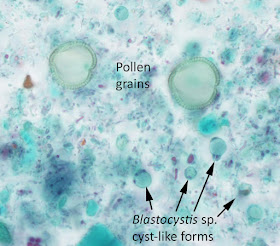Answer: Blastocystis sp. AND pollen.
Wow, you all impressed me by noting the less obvious Blastocystis in image 1, in addition to the pollen in all 3 images. Also, no one mistakenly thought that the pollen was a helminth egg (e.g. Taenia sp.) - a common pitfall. Excellent job!
While the Blastocystis cyst-like forms are the only parasites presents (image 1), I do agree that the pollen is the most striking finding. And very festive as Florida Fan and Idzi mentioned! I will defer the identification of the pollen to the others as this is outside of my area of expertise, but appreciate the time that some readers took to identifying the specific variety shown here.
Stay tuned for a holiday case next week.

Dear Dr. Pritt....with all due respect, allow me to partially disagree with your answer to this case study!
ReplyDeleteYou asked the following: "They measure approximately 10 to 20 micrometers in diameter. Identification?"
The answer should only be Blastocystis hominis or spp.
Pollen grains do not fit with the indicated measurement. Sure, pollen grains are there in the pictures but their purpose was probably to mislead or trick the inexperienced observer.
Happy holidays.
Pollen grains can absolutely be in the size range of 10-20 um. From Wikipedia for pollen: "The smallest pollen grain, that of the forget-me-not (Myosotis spp.), is around 6 µm (0.006 mm) in diameter."
ReplyDeleteThe link below shows a photomicrograph of a Brassicaceae pollen grain, with a diameter of 20um. To me, it strikingly resembles the images provided for this week's case.
http://apsa.anu.edu.au/sample/105-26-1/image/polar%20view?order=asc&sort=pic
- Mark Fox
Yes, that may be true for some kinds of pollen, but absolutely NOT the ones shown in the case study of this week. I guess they're no less than 50 um in diameter.
DeleteDear Ali and Mark, my apologies for the delay in getting back to you; I've been traveling internationally and haven't had reliable internet access. I wanted to go back to my original images to check the embedded scale bars and determine the actual sizes of the pollen and Blastocystis. Now that I finally am home and have access to my work server where the images are stored, I've discovered that I didn't keep the original images and therefore can only estimate the sizes.
ReplyDeleteAli, when I provided the images, I was highlighting the pollen (shown in all 3 images). The Blastocystis (shown in 1 image) was just a bonus. Therefore, the measurements I provided were of the pollen.
As Mark mentioned, pollen grains can be in the 10-20 micrometer range. According to the CDC DPDx website, Blastocystis range in diameter from 5 to 30 micrometers (average size is 8-10). If the smallest Blastocystis in the photos are 5 micrometers, then it would fit that the pollen is 20 micrometers in diameter, and thus the sizes would be correct as provided. Having said that, it's possible that I was using my 50x objective when taking the measurements of the pollen rather than 100x, and failed to multiple the size by a factor of 2.5 to get the final sizes. If we multiply 10-20 by 2.5, we get 25-50 micrometers. This would also fit the size of the pollen, and is probably the actual size range.
I apologize for all of the confusion. Thanks to you both for keeping me honest.
I wish you a very Happy Holidays and fabulous 2018!
Bobbi